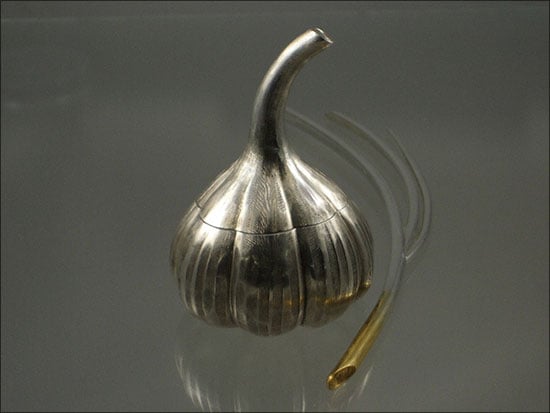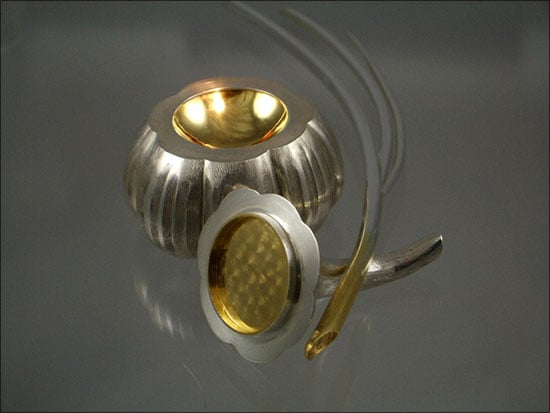Materials: sterling silver with 24 kt gold wash
Dimensions: Garlic 41/2" x 3" spoon 9"
Garlic Salt cellar with scallion spoon. Sterling silver with 24kt gold washed spoon and cellar bowls.
I made this life sized from an elephant garlic from my garden. It was featured in the James Beard Award winning book “Salted A Manifesto” by Mark Bittman.
Photo credit: Jo Haemer
Jo Gentry Haemer
Portland, Oregon. USA
I’m a second generation artist. I was born and partially raised in Europe, so we were dragged by my late father to every cathedral and museum he could find. As a result I became fascinated with the heavily jeweled reliquaries of the saint’s various body parts. I was a liturgical silversmith for awhile then became a custom jeweler. I still love to make boxes. I call them my “Caprichos” or caprices.
This piece I made after a fresh heirloom tomato from my yard. I used chasing tools inherited from the late Stephan Burkes who was a Faberge Jeweler. His chasing tools were made from the building spikes from the Nazi death camp where he was interred. He survived by trading the guards trinkets made with these tools for food to survive.
These containers and vessels definitely hold their place in the world of stunning art objects as well as in the world of metalsmithing.
Since the dawn of time humans have created containers to hold things that were important to them, from large vessels to hold food and harvests to intimate containers for small precious things. They might hold memories, ashes, medicine, beverage, fruit or food - but all spring from the imagination and skill of the maker. Some have specific religious functions, some are meant for everyday use. When one thinks of a vessel or container the inclination is to think of something with solid walls - yet many of these works involve the exploration of positive and negative space, and the use of negative space to help create the illusion of the wall of the vessel.
As the world’s largest jewelry related internet site, Ganoksin strives to develop exhibitions showcasing work from around the world. This exhibition was open to all metalsmiths, professional and amateur, advanced and beginner. Participants are from The Netherlands, the USA, Canada, Australia, Costa Rica, the United Kingdom, Israel, Hong Kong, Colombia, Romania, Italy, Ireland, Japan, Malaysia and Denmark. While most of the pieces are by an individual metalsmith, some are collaborations, one of three artists spanning 50 years.
In total 319 artists contributed 729 show pieces for the permanent online exhibition.
Objects in the exhibition include boxes, lockets, urns, ash containers, bowls, wine cups, reliquaries, match holders, vases, teapots, pitchers, sugar bowls, baskets, nests, pillboxes, clutches and a range of sculptural forms. A variety of techniques are showcased covering a wide range of metalsmithing techniques. Materials used include everything from gold and silver to less expensive metals. Ornamentation includes the addition of enamel, chasing and repousse’, gemstones and found objects.
The exhibition was curated by Beth Wicker, President of the North Carolina Society of Goldsmiths in the United States, and Adjunct Instructor at Northeastern Technical College in South Carolina. Director of the exhibition is Hanuman Aspler, founder of The Ganoksin Project, the world’s largest internet jewelry site.

